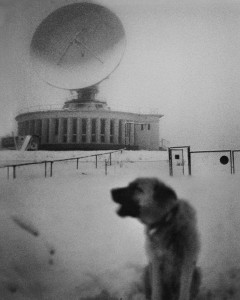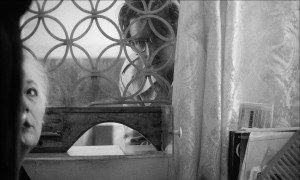【Watch I Did It For You Online】
White Noir
On Film

A man with a briefcase arrives in a place called City-A looking like a double agent from 1973: mustachioed and trenchcoated, forever ducking into phone booths for cryptic conversations. The man, Mr. Holz, is a geophysicist of unknown origin. He has come here to work for the New Method Oil Well Cementing Company. City-A is mesmerizingly bleak, a grid of concrete high-rises set between a brackish sea and a wintry industrial wasteland, all of it reeking of environmental contamination and failed utopia. Many things, Holz notices, are amiss here. Clocks don’t run sixty seconds to the minute in City-A. The drinking water is spiked with lithium, a shadowy entity has confiscated his passport, language is rationed, and what exactly is this New Method Oil Well Cementing Company, anyway? As the bewildered-looking Holz moves through the city, is he piecing together clues to solve these mysteries or just being shuttled around by a powerful unseen force?
This, roughly, is the storyline of whiteonwhite:algorithmicnoir, the new film by Eve Sussman and the Rufus Corporation. But because this noir is, as the title promises, algorithmic, the film has no beginning, middle, or end. At each screening, a computer program live-edits a movie out of more than three thousand film clips, eighty voice-overs, and 150 pieces of music. Each of these movable parts is marked with loosely content-related tags (“horizon,” “anxiety,” “white”), and the computer fits the pieces together according to an algorithm that matches tags. Sussman calls this apparatus the “serendipity machine.” Containing more than thirty hours of material, the movie never comes together the same way twice, and it never loops. A small screen to the side runs the metadata of the algorithm while the film plays, reminding viewers that a computer is chugging away busily as they watch, matching “discomfort” tags to “discomfort” tags, “surveillance” to “surveillance.”

Sussman is a British-born, Brooklyn-based artist and filmmaker who works both independently and in collaboration with the Rufus Corporation, a self-described “ad hoc think-tank” of performers, artists, musicians, writers, and programmers. Her first major piece with the company was 89 Seconds at Alcázar, a ten-minute video based on Diego Velázquez’s Las Meninasthat debuted to great acclaim at the 2004 Whitney Biennial. The Rape of the Sabine Women, an eighty-minute video musical inspired by Jacques-Louis David’s Intervention of the Sabine Women, followed in 2007. Continuing in the same vein, whiteonwhitealso takes its name from an iconic painting: Russian Suprematist Kazimir Malevich’s 1918 composition White on White. Like Malevich’s work, Sussman’s film deals with notions of limitless space, utopia, and transcendence. But the film has its origins at least as much in a trip to Kazakhstan as in Suprematism: around the same time Sussman decided to make a film named after White on White, an interest in actual space travel led her and collaborator Jeff Wood (the actor who plays Holz) to Central Asia to visit the Baikonur Cosmodrome, the world’s first and largest space-launch facility. Baikonur is a high-security place; when Sussman and Wood showed up there unannounced, the authorities swiftly arrested them and kicked them out. Rejected by the Cosmodrome, the filmmakers headed west across Kazakhstan until serendipity struck in the form of Aktau, an industrial port on the Caspian Sea. The Soviets built Aktau in the sixties as a planned city, a secret, closed uranium-mining settlement. To this day, the city has no street names; every address is a set of three numbers. Aktau “looks like a circuit board,” Sussman said in a recent interview with Filmmakermagazine. “Your address is like 3-36-12 or something; it’s sort of like you’re living inside a combination lock.” Aktau’s Alphaville-on-the-Kazakh-steppe appearance gave Sussman and Wood the idea of making a noir movie, and much of the film was shot there.

The booming Central Asian oil business, a layer of raw capitalism spread over the detritus of communist planning, is also present in the film. New Method Oil Well Cementing Company was the original name of the Halliburton Company. At one screening of whiteonwhiteat the Berlinale, the algorithm matched footage of oil pump-jacks with aphoristic voice-overs about extracting lithium from the brine pools of City-A. Whiteonwhiteplays with the motifs of resource scarcity and mineral extraction in more surprising ways, too, notably in the most intriguing problem Holz encounters: a language ration. Each person in City-A has a finite lifetime supply of each word, but nobody can know exactly what their individual ration for a given word is until it has run out, rendering the word forever unutterable. People are left to say “convey beaten dairy” when they have used up their rations of “please pass the butter.” Holz fears he might be close to running out of some commonly used words and tries to record them before it’s too late. In the world of whiteonwhite, the supply of language is limited, but the movie’s supply of time is infinite.

The film revels in its retro-futuristic aesthetic. “The place looked like the future,” a voice-over says. It resembled a comic book Holz had read as a child. Much of the material shot in Aktau looks like found footage; Sussman has described it as “archival footage from the future.” Shots linger on analog objects: flip clocks, rotary dials, and reel-to-reel tape recorders. A factory scene in what looks like a 1970s stage set was actually filmed in a currently functioning all-analog chemical factory in Aktau. At times City-A comes across as one big clockwork machine, the analog counterpart to the digital serendipity machine. “You are mistaken about the nature of cities,” a voice-over scolds crisply, “and you are mistaken about the nature of our city. City-A is not a machine.”
The atmosphere of City-A is dank, paranoid, and downright suspenseful. One of the most surprising things about whiteonwhiteis how well the algorithmic editing apparatus pulls off a movie that really feels like film noir. In his 1972 essay “Notes on Film Noir,” Paul Schrader wrote of noir as a mood, not a genre, in which “a complex chronological order is frequently used to reinforce the feelings of hopelessness and lost time … The manipulation of time, whether slight or complex, is often used to reinforce a noir principle: the how is always more important than the what.” The way the serendipity machine manipulates time is utterly new, but the stylized and disoriented world it plunges the viewer into is quintessentially noir.
Jane Yager is a writer and translator living in Berlin.
Search
Categories
Latest Posts
David Orr: Lost in the Archives, Summer 1996 by David Orr
2025-06-26 12:12Dummy Land by Avi Steinberg
2025-06-26 11:56TPR vs. NYM: Bittersweet Victory by Cody Wiewandt
2025-06-26 11:51Popular Posts
Best headphones deal: Save up to 51% on Beats at Amazon
2025-06-26 11:59Poem: Remembering the Children of First Marriages by Lucy Tunstall
2025-06-26 11:43Wells Tower, DBC Pierre, and Tobias Wolff by Chris Flynn
2025-06-26 11:15David Orr: Lost in the Archives, Summer 1996 by David Orr
2025-06-26 10:28A worthless juicer and a Gipper-branded server
2025-06-26 10:03Featured Posts
Best iPad deal: Save $132 on Apple iPad (10th Gen)
2025-06-26 12:19Singing Cowgirl; Cigarette Boy by Chris Flynn
2025-06-26 11:25Adaptation by Sadie Stein
2025-06-26 11:10Busker; Deposition Delivery by Chris Flynn
2025-06-26 11:07Barcelona Open 2025 livestream: Watch live tennis for free
2025-06-26 10:58Popular Articles
Nintendo Switch 2 preorder just days away, per leak
2025-06-26 12:34Adaptation; Fall Reading by Lorin Stein
2025-06-26 12:22Complexity and Contradiction; Reading Audiobooks by Lorin Stein
2025-06-26 12:02Staff Picks: Dioramas, Donald Young and Stardom by The Paris Review
2025-06-26 11:1010 Tech Predictions for 2017
2025-06-26 10:10Newsletter
Subscribe to our newsletter for the latest updates.
Comments (11843)
New Knowledge Information Network
Astronomers saw one galaxy impale another. The damage was an eye
2025-06-26 12:20Information Information Network
Reading 'House of Holes' in Public by Andrew Palmer
2025-06-26 12:13Wisdom Convergence Information Network
Staff Picks: Food, Fiction, and Summer Dresses by The Paris Review
2025-06-26 11:37Miracle Information Network
The Beach Towel: Now for Sale! by The Paris Review
2025-06-26 11:18Progress Information Network
'Mario Kart World' Nintendo Direct: 3 takeaways
2025-06-26 10:56